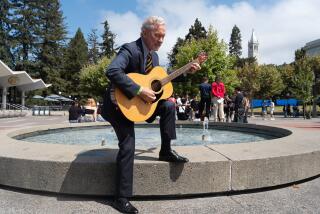Editorial: What’s next for Berkeley and UC?
The grand disagreement between Gov. Jerry Brown and University of California President Janet Napolitano has never been resolved. There have been some cease-fires, one showdown and a couple of deals struck. But the deeper argument remains: What sort of institution should the University of California be in the years ahead? Will it continue to be the gem of the California public education system, admired and emulated throughout the world, or must it shrink its ambitions and its offerings as its state funding continues to decline? Can its most selective campuses continue to attract applications from the highest-achieving students in the nation and the world, and is that even desirable? Or should its undergraduate programs be reserved mostly for California residents? Will large numbers of students be funneled into massive online courses that are less educationally sound? Who is going to pay for the large and increasing numbers of low-income students who receive a full tuition ride to UC?
The public’s frustration with the wildly expensive cost of a college education ... is reaching fever pitch.
These weighty questions are being taken up by UC Berkeley Chancellor Nicholas Dirks. Citing his campus’ large and growing deficit, Dirks has said he is rethinking university operations from the ground up. Very little will be off the table in his examination of education and expenditure. Academic departments might merge and online courses might replace some of the traditional offerings. Strangely, one of the few areas where Dirks has promised not to cut is in the number of sports teams — though there could be trims in the athletics budget. That program is among those that has been operating at a deficit. But if this is to be a true reexamination, why not put everything on the table? Does Cal really need more than two dozen intercollegiate teams to remain a world-class university?
In the struggle between the governor and the University of California, it is Brown who is mostly in the wrong. He seems not to recognize that UC is the part of California’s public education system that works best. Despite rising tuition prices and much belt-tightening — simply getting into a desired course can be an entire education in frustration — UC, and especially its top-ranked campuses, have managed to retain a significant portion of the luster of pre-Proposition 13 days. Berkeley, even at full price, is still an educational icon, regularly rated the best public university in the world. UCLA is close behind.
World-class higher education and research that benefits society are worth preserving for their inherent value. But UC also has a history of drawing brilliant and talented people to California who open new businesses and create new industries and offer high-paying jobs, and contribute to the state in many other ways. Yet Brown seems to envision a university that, above all else, moves students expeditiously on toward graduation through online courses and three-year degree programs and other shortcuts.
These aren’t necessarily bad, in and of themselves. Some students learn well in online courses and appreciate the flexibility. But the best courses require instructors to answer questions and help students stay on track — whether they’re online or in a room with a live professor. That means high-quality online courses cost almost as much as the bricks-and-mortar kind.
Dirks’ re-imagination of Berkeley is important, not just for his campus or for UC, but for higher education across the country. The public’s frustration with the wildly expensive cost of a college education — and what appears to them like a capricious system for admitting or rejecting applicants — is reaching fever pitch. Why can’t we have free college education for all, parents and students want to know, like so many countries in Europe have? Why does there seem to be a college arms race for big-name professors who might not be good teachers, or big-name administrators whose compensation sometimes nears seven figures?
Things do have to change. But in deciding what to keep and what to toss, Dirks and others should focus most on how students’ education will be affected. It would be a shame, for instance, to lose great traditional programs in literature or philosophy because many people think — wrongly — that there is no way to transfer these skills to the professional world. (English and philosophy are both excellent preparation for law school and other careers requiring writing and analytical skills.) Universities should continue to require a liberal arts education, and their rigor should not be softened to help students get through more quickly.
And the top priority at the UCs should be to educate the students of this state. Some mix is desirable; out-of-state students can bring diversity and academic vigor to a school. But with out-of-state admissions now at a third of students, while fully qualified California residents are being denied entry, the university is failing in its primary mission. Certainly, financial aid for out-of-state undergraduates should end except in truly exceptional cases.
This is an opportunity to rethink not just finances but the very definition of a college education. It is worth examining the system in many European countries, where college is free but also is a stripped-down version of what Americans think of as higher education — including less personal interaction with professors and more independence required of students.
In the end, though, Brown will have to recognize that providing great university education costs money — and that the investment will repay the state and its residents in many ways.
So go ahead, Chancellor Dirks, redesign the most admired public university in the world. No pressure. But the world of higher education is watching.
Follow the Opinion section on Twitter @latimesopinion and Facebook
More to Read
A cure for the common opinion
Get thought-provoking perspectives with our weekly newsletter.
You may occasionally receive promotional content from the Los Angeles Times.










